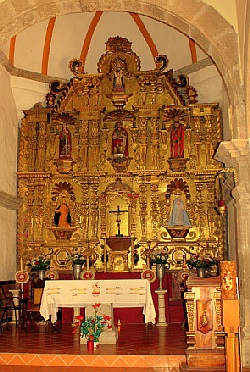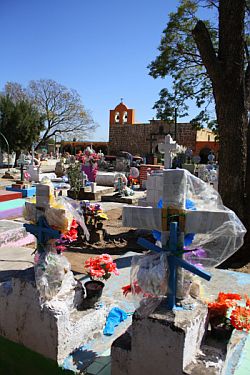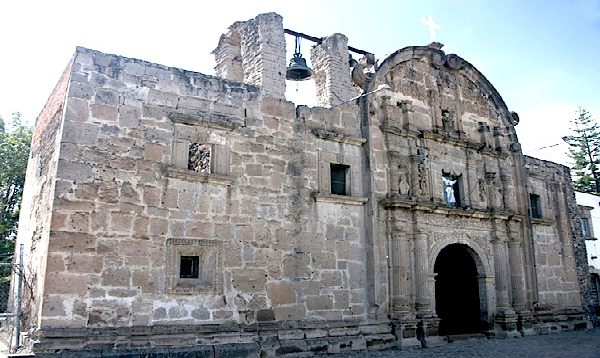San Juan Evangelista, Jalisco, Mexico - I’d have counted it a very rewarding day if it ended with my visit to the studio of barra (clay working) maestro Martín Ibarra Morales in Jalisco’s San Juan Evangelista. It turned out instead that the studio visit was but a taste of what would soon reveal itself along the shores of Lake Cajititlan.
Spanish soldiers and Catholic missionaries arrived here on horseback within 50 years of Columbus’ first arrival in the New World and within 10 years after Tenochtitlan (now Mexico City) fell to Cortes, pressing toward the Pacific Ocean and ever in search of more gold.
From its first expansion beyond the boundaries of the Roman Empire, Catholicism has time and again promoted conversion of pagan peoples by incorporating aspects of their religions into its own imagery and rituals. In few places is its chameleon bent as widely evident as in Mexico, and nowhere in my experience as pervasively as in San Juan Evangelista.
 |
| Church alter tableau in gilded wood |
Martín guides me and my Mexican artist and friend Jesús López Vega across the street to where a church dating from the 1600’s stands adjacent to a graveyard. Like many buildings of the period in this part of the world, this church was constructed by indigenous craftsman under the direction of priests.
To the untrained eye it looks like many Spanish Catholic churches, but Martin knows better and he shares his insights with us as he points out features of the building’s architectural detail. It becomes quickly apparent that things are not what they first might seem.
If the priests believed that ministrations backed by Spanish arms would irrevocably convert native people to Christianity, they were indulging far more in wishful thinking than they were ever to know.
Hidden within the elaborate stone façade are icons of the native religion, speaking in seditious code to a people conquered, but undefeated.
In Christian tradition the serpent is a personification of the Devil, but in native religion the plumed serpent is a deity that archeologists say first appeared in Mexico during the time of Christ.
 |
| Cemetery in San Juan Evangelista |
Soon the artist in Martín can't resist any longer and he stoops to reproduce the façade’s scrollwork in the dust, showing how its unusual double-scroll pattern is actually a serpent. Feline faces that adorn drain spouts just below the roof line high above are decidedly un-Christian images of jaguars.
We enter the church through a side door that shows every sign of being part of the original construction, its edge worn smooth by worshipers’ hands over the course of more than 300 years. Inside, Martín points out more indigenous icons hidden within the three-story-high carved imagery behind the altar. They also adourn the designs of carved cantera stone above the doorways.
He recounts a story long told in his village that priests discovered – years after completion of the construction – that the native workers had hollowed out statues of saints which adorn the interior, and placed within their hollowed spaces images of their native gods. It’s a remarkable demonstration of faith that can’t help but inspire.
If I concluded on the strength of this visit that such pagan imagery within Catholic churches was a thing of the distant past, though, my view was soon to be set on its ear by what I next saw as we rounded the western edge of the lake and doubled back on the other side toward the town of Cajititla...


